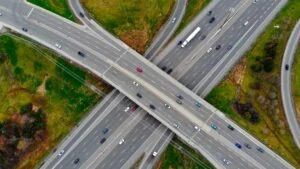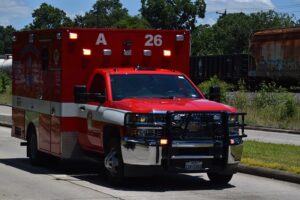
How can you tell the difference between a freeway and a highway? In 2025, the difference between a freeway and a highway is that a freeway is a fully controlled access road, while a highway can have varying levels of access control.
Freeways are designed for uninterrupted traffic flow, with no stoplights, intersections, or pedestrian crossings. Highways, on the other hand, may include traffic signals, cross streets, and direct access to businesses or homes.
Understanding the differences between these road types is important, especially when evaluating fault and legal liability after a crash. If you’ve been involved in one, a Los Angeles car accident lawyer can help you file a claim and pursue compensation.
Key Differences Between Highways and Freeways in 2025
The differences between a highway and a freeway in 2025 lie in their access control and traffic flow. A freeway is a fully controlled-access road, meaning vehicles can only enter and exit at designated access ramps. There are no intersections, traffic lights, or pedestrian crossings.
In contrast, a highway is a more general term for major roads with varying levels of access control. Some are controlled-access, like freeways, while others have intersections, traffic signals, and direct access to businesses and residential areas.
While all freeways are highways, not all highways are freeways.
Controlled Access vs. Direct Access
The primary distinction between these two types of roadways is access control. A freeway is a controlled-access roadway, meaning vehicles can only enter or exit at designated entry and exit ramps. These roads do not have intersections, traffic signals, or direct access from adjacent properties.
In contrast, a highway may have direct access points, traffic lights, and intersections. Highways can include major roadways, state routes, and arterial streets.
Speed and Efficiency
Due to their uninterrupted design, freeways generally allow for higher speed limits than highways. In most areas, freeway speed limits range from 65 to 85 miles per hour. Since freeways eliminate stoplights and cross traffic, they enable smoother and more predictable driving conditions.
Highways, on the other hand, may have lower speed limits because they intersect with other roads, contain pedestrian crossings, and experience traffic congestion at lights. The presence of these obstacles means drivers must adjust speeds more frequently, increasing travel time.
Infrastructure and Design
Modern freeway infrastructure incorporates multiple lanes, overpasses, underpasses, and merging lanes to maintain traffic flow. Many freeways in 2025 also include smart road technologies, such as real-time traffic monitoring, adaptive speed limits, and automated toll collection systems.
While still built for heavy traffic, highways vary significantly in design. Some are multi-lane expressways with partial access control, while others are simple two-lane roads connecting rural areas. Many still rely on traditional traffic signals and stop signs.
Which Is Better, a Freeway or a Highway?
The answer as to which type of roadway is better will depend on where you‘re traveling. Freeways are ideal for long-distance, high-speed vehicular travel without interruption, whereas highways are better for short, local commutes.
Regional Variations in Terminology
The terminology used to describe the difference between a freeway, a highway, and other roads in 2025 can vary across regions. Here are some examples:
- Freeway: In the U.S., this refers to a fully controlled-access, high-speed road with no intersections or stoplights.
- Highway: This is a broad term that includes all major types of roads, including freeways, expressways, and arterial roads.
- Interstate: Part of the U.S. Interstate Highway System, interstates are federally funded, controlled-access highways designed for long-distance travel across multiple states.
- Expressway: In some states, this term refers to a road with limited access control.
- Turnpike: This is a toll road, often a controlled-access highway, used to generate revenue for maintenance and infrastructure projects.
If you’re planning to travel, it’s important to understand these distinctions, as the same type of road may have different names and regulations in different places.
Is a Freeway Faster Than a Highway?
Yes, a freeway typically allows for faster travel thanks to its design and lack of stoplights and intersections. The uninterrupted flow of traffic allows vehicles to maintain higher speeds over long distances.
Is a Freeway Bigger Than a Highway?
Yes, freeways are generally larger in scale. Most freeways feature multiple lanes in each direction, wider shoulders, and extensive interchanges to handle high traffic volumes. Highways can range in size, with some being as wide as freeways and others being simple two-lane roads.
Is It More Dangerous to Drive on a Freeway or a Highway?
There are risks to driving on both types of roadways, but statistics suggest that highways with direct access points and intersections pose a higher risk of accidents. The presence of pedestrians, cyclists, and cross traffic increases the likelihood of collisions.
That said, freeway accidents can be particularly severe. Vehicles tend to be traveling at higher speeds, and there’s a greater potential for multi-vehicle pileups.
How Is a Turnpike Different?
A turnpike is a specific type of freeway that requires a toll. These toll roads use electronic toll collection or toll booths. Turnpikes help fund road maintenance and infrastructure projects.
Contact a Los Angeles Car Accident Lawyer Today
Accidents on high-speed roads can result in severe injuries. What’s more, determining fault can be complex. Filing a claim without a personal injury lawyer can be a tall task.
If you’ve been involved in a crash on a freeway or highway, a skilled Los Angeles car accident attorney from Omega Law Group can help you manage the legal process and fight for fair compensation.
Don’t wait to seek justice. Schedule a free consultation today to discuss your legal options.





